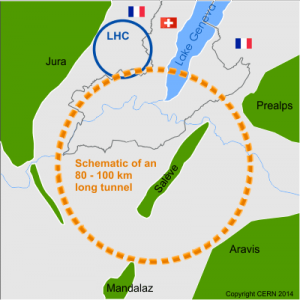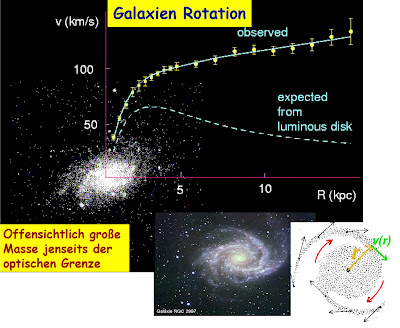Red Baron blogged a couple of times about particle physics and his former workplace, CERN (here and here).
Recently,
Karl Jakobs, professor of experimental particle physics at the University of Freiburg,
gave a talk at the Museumsgesellschaft titled
CERN and the Search for the Tiniest Building Blocks of Matter.
In the run-up to this lecture, some friends told me that the topic was too
complex for them and they would not come.
There are many reasons for their attitude. In my generation, many still boast
that they didn't understand anything about physics at school. Others of my age
are more knowledgeable. They had just gotten into physics class as far as Bohr's
atomic model, but they hadn't been interested in the advances in physics since then.
The auditorium was less packed than at other lectures. Red Baron, on the
other hand, got his fill. Leaning back in my chair, I let the slides of the
standard model - Professor Jakobs said standard theory - pass in review.
In addition to particle physics, the lecturer presented the big CERN
accelerator, the Large Hadron Collider, and the four experimental facilities at
the LHC. For many years, Professor Jakobs was the spokesperson for ATLAS, the
largest experiment at the LHC.
Here are my thoughts instead of a lecture report (
View Professor Jakob's slides): I love the Standard Theory and the Higgs Boson. I've blogged about those
topics before (
here
and
here).
Following the discovery of the Higgs, physicists working at the big
experiments at CERN are desperately searching beyond the Standard Theory for a
"New Physics," which the theorists call for in ever-new mathematical
approaches.
Professor Jakobs disagreed and said that the precise measurement of the Higgs
particle could reveal discrepancies. Is there more than one Higgs particle? He
showed the following graphics:

|
|
Over the last ten years, the precision of the Higgs particle mass (blue)
has increased dramatically.
|

|
As one would expect, the strength of the interaction of the Higgs is
proportional
to the mass of the particles from μ, the light
muon, to t, the heavy top quark.
Click the graphic to enlarge.
|
Einstein's general theory of relativity encounters inconsistencies when applied
in space.
The discrepancy between observed and measured rotation velocities of
galaxies points to big masses beyond the optical limit. In addition to this
dark matter, there must be dark energy to reconcile Einstein's theory with
the measurements.
Astrophysicist
Neil deGrasse Tyson
introduced me to dark matter and wrote about dark energy in his
books.
In the discussion following Prof. Jakobs' lecture, the wish arose to
listen to an astrophysicist on the "dark topic." My spontaneous suggestion
to fly in Neil deGrasse Tyson from New York to explain the subject was not
very helpful.
Not all young physicists working at CERN may stay in high-energy physics.
Professor Jakobs gave an interesting breakdown of this.
According to the graphic, only 8% of physicists remain in high-energy
physics. Still, 35% end up in Information Technology, although IT has established itself as an independent field of science in the meantime.
Employers prefer people with practical experience to those who have
just graduated.
Red Baron remembers a discussion at CERN in the 1970s when the academic job
market was somewhat limited. Regarding job opportunities, Director Mervin
Hine emphasized that CERN physicists had no problem finding a job. He backed
up his statement by saying, "A physicist can do anything," but added to his
reassuring statement with fine British humor, "Almost."
Stephen Hawking once wrote, "The great advances in physics have come
from experiments that gave results we didn't expect." How true. These are
the great moments in physics.
Red Baron remembers it like yesterday: In 1974, two physicists in the
States,
Burton Richter
at the Stanford Linear Accelerator Center and
Samuel Chao Chung Ting
at the Brookhaven National Laboratory, simultaneously discovered the J/ψ
particle, a quark compound of charm and anti-charm nobody had been waiting
for.
The discovery was one of those magic moments in physics. It made theoretical
physicists sweat in their attempts to explain the new particle. To make a
long story short, the experimental discovery of the intermediate boson J/ψ
opened up a whole new physics that eventually led to today's Standard Model or Theory.
Experimental physicists at CERN are looking forward to the coming upgrade of
the Large Hadron Collider to higher intensities. At 13.7 GeV, the LHC's magnetic field is pushed to its limit, having almost reached its design
energy of 14 GeV. So, higher energies can only be achieved with a larger
accelerator.

|
Planning the Future Circular Collider (FCC) ©CERN
All other slides
©Prof. Jakobs
|
A machine with a circumference of up to 100 km is being studied at CERN. Where can the money be found?
China is going ahead with another project. Scientists at the Institute of
High Energy Physics (IHEP) in Beijing plan to build a "Higgs factory" by
2028 - a 52-kilometre underground ring that would smash electrons and
positrons together.
Collisions of these fundamental particles would allow the Higgs boson to be
studied with great precision. More Higgs are to come.
*






Vielen Dank, lieber Manfred - habe natürlich auch NICHTS verstanden, fand den Vortrag aber brilliant: geht sowas? Deine Bine
ReplyDeleteVerstehen, liebe Sabine, ist ein großes Wort. Ich glaube nach einem Privatissimum meinerseits wirst Du etwas klarer sehen. Gruß Manfred
ReplyDelete